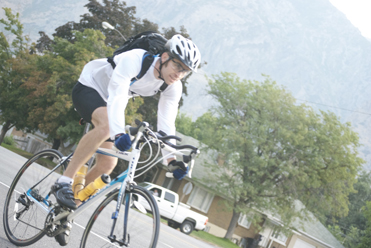





I avidly cycled over 2008–2012. Using an iAero (a wireless power meter formerly made by Velocomp) on my racing bike, I gathered data from every ride. The majority of my rides were in 2009, 2010, and 2011; what follows are cumulative totals for all rides:
Distance: 9,078.309 miles
Time on bike: 568:16:33 (HHH:MM:SS)
Energy expended: 344,626 kJ
Vertical climbing: 265,344 feet
Pedal revolutions: 2,670,500
A power meter is a great tool to gather data and compare cycling races, rides, and workouts. Many variables factor into how long a ride takes, such as environmental and road conditions (e.g., wind, rain, potholes, traffic), position on the bike (aerodynamics), and the possibility of drafting in group rides or races to conserve energy. For this reason, normalized power (NP) is often used as a metric to compare physical exertion from one ride to another, despite these many variables. NP is calculated by taking the power output at each time interval to the fourth power, summing all these results, and then taking the fourth root of that sum (akin to radiation heat transfer).
However, while NP can provide a means of comparing efforts, a given NP for one person will likely not yield the same distance traveled for another due to differences in bikes (e.g., differences in tire rolling resistance, frictional losses in the gear train, etc.), riding position, weight, etc. Indeed, a cyclist riding at a NP of 200 Watts while sitting up will not travel nearly as far as if he output the same NP while staying in a streamlined, aerodynamic position.
To overcome such problems in providing direct comparisons, I decided to calculate normalized distances for each ride. This is quite a bit more complicated than an NP calculation and requires a power meter that gathers additional data (e.g., wind speed) in addition to calibration runs to determine other pertinent variables. Click here for a detailed description of this calculation method and figures of power and speed output, all generated using Matlab. Conducting such calculations for all rides where necessary data is available produced the following sums:
Distance: 9,078.309 miles
Distance (no wind): 8,937.737 miles (–1.55%)
Distance (no wind and flat): 9,266.921 miles (+2.08%)
When the effect of wind (both head winds and tail winds) is taken into account, my overall distance traveled falls by about 140 miles (1.55%). Apparently, I'm good at avoiding head winds and finding tail winds, on average. However, when the effect of elevation changes (e.g., going up and down mountains) is taken into account, my overall distance traveled rises by almost 330 miles (compared to the windless distance), which amount stands almost 190 miles (2.08%) above the initial value. In other words, I traveled over enough mountains that I would have gone 330 miles further (in the same wind conditions) or 190 miles further on an indoor trainer or in a velodrome. Note that this flat calculation includes all the speed losses from going up mountains in addition to the speed gains from coasting back down the mountains (i.e., as fast as you might fly down a mountain, you'll go farther for a given amount of energy if you avoid it altogether).

During the summer of 2010 I biked much of the way from Provo, UT down to Mesquite, NV, winding through a part of AZ. My power meter gives me lots of interesting data about every ride: bike speed, wind speed, power output, distance traveled, cadence, heart rate, elevation, road grade, and temperature (captured every one second for most rides). Interesting summary data for this 5-day trip include:
Distance: 402.471 miles
Distance (no wind): 446.026 miles (+10.8%)
Distance (no wind and flat): 489.002 miles (+21.5%)
Energy expended: 18,161 kJ
Vertical climbing: 27,906 feet
Pedal revolutions: 119,483
Temperature: 45 to 111°F
Maximum wind speed: 42.1 mph
I hit so many headwinds during that trip, that I could have traveled almost 44 additional miles had there been no wind (headwinds and tailwinds). When elevation changes are also removed, an additional 43 miles would have resulted, totaling almost 87 additional miles had I biked in a velodrome or on an indoor trainer.
During the previous summer, I did a similar tour, heading west across much of UT, NV, and CA. Heading westward across Nevada, I experienced many headwinds and high heat. Summary data from this ride follows:
Distance: 456.048 miles
Distance (no wind): 484.601 miles (+6.26%)
Distance (no wind and flat): 486.894 miles (+6.76%)
Energy expended: 13,302 kJ
Vertical climbing: 20,514 feet
Pedal revolutions: 139,309
Temperature: 55 to 120°F
Maximum wind speed: 40.7 mph